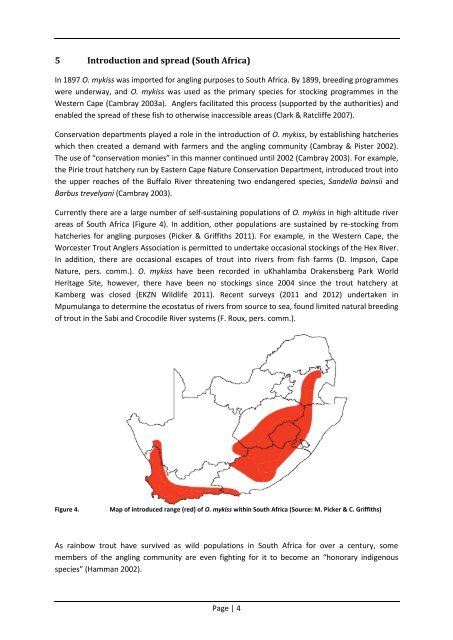Rainbow Trout Oncorhynchus mykiss - Department of Agriculture ...
Rainbow Trout Oncorhynchus mykiss - Department of Agriculture ...
Rainbow Trout Oncorhynchus mykiss - Department of Agriculture ...
You also want an ePaper? Increase the reach of your titles
YUMPU automatically turns print PDFs into web optimized ePapers that Google loves.
5 Introduction and spread (South Africa)In 1897 O. <strong>mykiss</strong> was imported for angling purposes to South Africa. By 1899, breeding programmeswere underway, and O. <strong>mykiss</strong> was used as the primary species for stocking programmes in theWestern Cape (Cambray 2003a). Anglers facilitated this process (supported by the authorities) andenabled the spread <strong>of</strong> these fish to otherwise inaccessible areas (Clark & Ratcliffe 2007).Conservation departments played a role in the introduction <strong>of</strong> O. <strong>mykiss</strong>, by establishing hatcherieswhich then created a demand with farmers and the angling community (Cambray & Pister 2002).The use <strong>of</strong> “conservation monies” in this manner continued until 2002 (Cambray 2003). For example,the Pirie trout hatchery run by Eastern Cape Nature Conservation <strong>Department</strong>, introduced trout intothe upper reaches <strong>of</strong> the Buffalo River threatening two endangered species, Sandelia bainsii andBarbus trevelyani (Cambray 2003).Currently there are a large number <strong>of</strong> self-sustaining populations <strong>of</strong> O. <strong>mykiss</strong> in high altitude riverareas <strong>of</strong> South Africa (Figure 4). In addition, other populations are sustained by re-stocking fromhatcheries for angling purposes (Picker & Griffiths 2011). For example, in the Western Cape, theWorcester <strong>Trout</strong> Anglers Association is permitted to undertake occasional stockings <strong>of</strong> the Hex River.In addition, there are occasional escapes <strong>of</strong> trout into rivers from fish farms (D. Impson, CapeNature, pers. comm.). O. <strong>mykiss</strong> have been recorded in uKhahlamba Drakensberg Park WorldHeritage Site, however, there have been no stockings since 2004 since the trout hatchery atKamberg was closed (EKZN Wildlife 2011). Recent surveys (2011 and 2012) undertaken inMpumulanga to determine the ecostatus <strong>of</strong> rivers from source to sea, found limited natural breeding<strong>of</strong> trout in the Sabi and Crocodile River systems (F. Roux, pers. comm.).Figure 4.Map <strong>of</strong> introduced range (red) <strong>of</strong> O. <strong>mykiss</strong> within South Africa (Source: M. Picker & C. Griffiths)As rainbow trout have survived as wild populations in South Africa for over a century, somemembers <strong>of</strong> the angling community are even fighting for it to become an “honorary indigenousspecies” (Hamman 2002).Page | 4
















